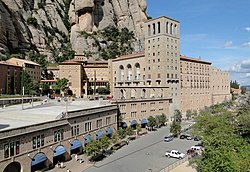Santa Maria de Montserrat Abbey



Santa Maria de Montserrat (Catalan pronunciation: [ˈsantə məˈɾi.ə ðə munsəˈrat]) is a Benedictine abbey located on the mountain of Montserrat, in Monistrol de Montserrat, in Catalonia, Spain.
It hosts the Virgin of Montserrat, and the Publicacions de l'Abadia de Montserrat, a publishing house, one of the oldest presses in the world still running,[1][2] with its first book published in 1499.
The monastery is Catalonia's most important religious retreat and groups of young people from Barcelona and all over Catalonia make overnight hikes at least once in their lives to watch the sunrise from the heights of Montserrat. Virgin of Montserrat (the black virgin), is Catalonia's favourite saint, and is located in the sanctuary of the Mare de Déu de Montserrat, next to the Benedictine monastery nestling in the towers and crags of the mountain. The Escolanía, Montserrat’s Boys’ Choir, is one of the oldest in Europe, and performs during religious ceremonies and communal prayers in the basilica. Montserrat, whose name means serrated mountain, is 48 kilometres (approx 30 miles) west of Barcelona, and can be reached by road, train or cable car.
At 1236 metres (4055 ft) above the valley floor, Montserrat is the highest point of the Catalan lowlands, and stands central to the most populated part of Catalonia. The stone monolith is ideally located to play an important role in the cultural and spiritual life of Catalonia.
The Basilica houses a museum with works of art by many prominent painters and sculptors including works by El Greco, Dalí, Picasso and more. Montserrat's highest point, Sant Jeroni, can be reached by a footpath from the top station of the funicular Sant Jeroni. From Sant Joan, almost all of Catalonia can be seen, and on a clear day the island of Mallorca is visible.
Notable abbots
Civil War Years
The Spanish Civil War saw the violent suppression of the Abbey of Montserrat. Of the 278 priests and 583 religious men and women killed in Catalonia by Republican forces, [3] 22 were monks of the Abbey of Montserrat. [4]
Franco Years
During Franco's rule, Santa Maria de Montserrat was seen as a place of refuge for scholars, artists, politicians and students; Franco's men were often waiting for wanted people a few miles down the road.[5]
From the 1940s onward, Santa Maria de Montserrat was often seen as a symbol of Catalan nationalism. [6] On 27 April 1947, a Mass to celebrate the Enthronment of the Virgin of Montserrat was held, attended by over 100,000 people. [6] At this Mass, prayers were publicly spoken in the Catalan language, in defiance of the government's policies. [6]
In December 1970, 300 Spanish artists and academics held a sit-in protest at the monastery against the death sentences of 16 Basque ETA activists in Burgos; in response police sealed off the monastery. [7] [8] The protesters were eventually removed from the monastery, but their action helped convince the government to commute the death sentences. [9]
See also
References
- ^ La impremta a Montserrat. Manuel Llanas. Universitat de Vic, 2002.
- ^ Cinc-cents anys de Publicacions de l'Abadia de Montserrat. Faulí, Josep, Francesc Xavier Altés i Aguiló & Josep Massot i Muntaner. Publicacions de l'Abadia de Montserrat, 2005.
- ^ Archdiocese of Barcelona website
- ^ Don Quixote website, the Monastery of Montserrat
- ^ MacNeil, Karen. The Wine Bible, p. 466.
- ^ a b c Conversi, Daniele. The Basques, the Catalans, and Spain: Alternative Routes to Nationalist Mobilisation University of Nevada Press, 2000 ISBN 0874173620, (p 126-127).
- ^ "Basque Trial Protesters Sealed Off", Associated Press, in Press-Courier, Dec 14, 1970, (pg. 9).
- ^ Mcneill, Donald, Urban change and the European left: tales from the new Barcelona Routledge, 1999. ISBN 0415170621, (p. 142).
- ^ "After the Burgos Trials", Juan Marchial, Boston Globe, December 30, 1970 (p.8).
External links
- Abbey's web
- Publicacions de l'Abadia de Montserrat
- Montserrat virtual (3D)
- Abbey and Escalonia Choir Photo Gallery
